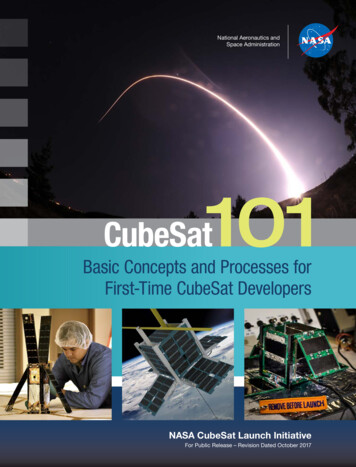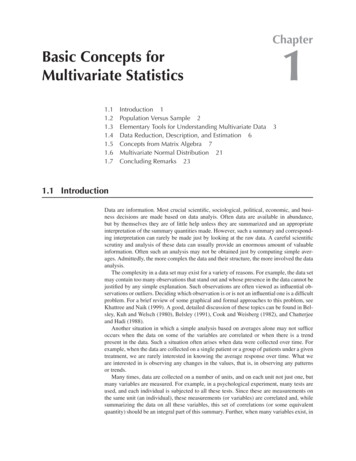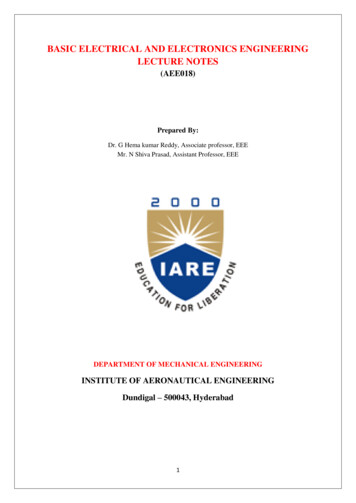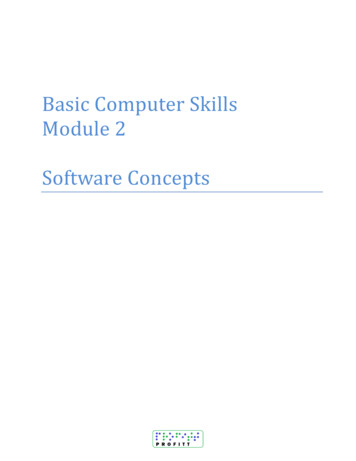
Transcription
National Aeronautics andSpace Administration101CubeSatBasic Concepts and Processes forFirst-Time CubeSat DevelopersNASA CubeSat Launch InitiativeFor Public Release – Revision Dated October 2017
101CubeSatBasic Concepts and Processes forFirst-Time CubeSat DevelopersNASA CubeSat Launch InitiativeFor Public Release – Revision Dated October 2017
Produced under contract by theCalifornia Polytechnic State University, San Luis Obispo (Cal Poly) CubeSat Systems Engineer LabAcknowledgementsThis guide was produced by the following to support NASA’s CubeSat Launch Initiative:Writers and ContributorsCalifornia Polytechnic’s PolySat Program,California Polytechnic State University—San Luis ObispoJamie ChinRoland CoelhoJustin FoleyAlicia JohnstoneRyan NugentDave PignatelliSavannah PignatelliNikolaus PowellJordi Puig-SuariNASA Launch Services ProgramWilliam Atkinson, Kennedy Space CenterJennifer Dorsey, Kennedy Space CenterScott Higginbotham, Kennedy Space CenterMaile Krienke, Kennedy Space CenterKristina Nelson, Kennedy Space Center/ai SolutionsBradley Poffenberger, Kennedy Space CenterCreg Raffington, Kennedy Space CenterGarrett Skrobot, Kennedy Space CenterJustin Treptow, Kennedy Space CenterAnne Sweet, NASA HeadquartersNASA Advanced Exploration Systems DivisionJason Crusan, NASA HeadquartersCarol Galica, NASA Headquarters/Stellar SolutionsNASA Space Communications and Navigation DivisionWilliam Horne, NASA Headquarters SpaceCommunications and Navigation SpectrumManagementNASA Jet Propulsion LaboratoryCharles Norton, Jet Propulsion LaboratoryFormulation Lead for Small SatellitesNOAAAlan Robinson, NOAA Commercial Remote SensingRegulatory Affairs OfficeEditors and Graphic DesignerCommunications Support Services CenterMaxine Aldred, NASA Headquarters/Media FusionAndrew Cooke, NASA Headquarters/Media FusionTun Hla, NASA Headquarters/Media FusionMichele Ostovar, NASA Headquarters/Media FusionJennifer Way, NASA Headquarters/Media FusionFor more information visit: http://go.nasa.gov/CubeSat initiativeiiCubeSat 101: Basic Concepts and Processes for First-Time CubeSat Developers NASA CubeSat Launch Initiative
CubeSat101Table of ContentsAcknowledgments. . . . . . . . . . . . . . . . . . . . . . . . . . . ii1Introduction211.1CubeSats. . . . . . . . . . . . . . . . . . . . . . . . 41.2CubeSat Dispenser Systems. . . . . . . . . . . . . . 41.3Pictured above:1.2.1 3U Dispensers51.2.2 6U Dispensers6NASA mentors and the student launchteam for StangSat and PolySat gothrough final checks in the CubeSat labfacility at Cal Poly. [VAFB/Kathi Peoples]Launch Vehicles (LVs)—aka: Rockets. . . . . . . . . . 6Development Process Overview2.1Concept Development (1–6 months). . . . . . . . . . 112.2Securing Funding (1–12 months) . . . . . . . . . . . . 112.3Merit and Feasibility Reviews (1–2 months) . . . . . . . 142.4CubeSat Design (1–6 months) . . . . . . . . . . . . . 152.5Development and Submittal of Proposal in Responseto CSLI Call (3–4 months). . . . . . . . . . . . . . . . 172.6Selection and Manifesting (1–36 months). . . . . . . . 182.7Mission Coordination (9–18 months) . . . . . . . . . . 192.8Regulatory Licensing (4–6 months). . . . . . . . . . . 202.9Flight-Specific Documentation Development andSubmittal (10–12 months). . . . . . . . . . . . . . . . 219CubeSat 101: Basic Concepts and Processes for First-Time CubeSat Developers NASA CubeSat Launch Initiativeiii
CubeSat101Table of Contents2.10 Ground Station Design, Development, and Testing(2–12 months). . . . . . . . . . . . . . . . . . . . . . 222.11 CubeSat Hardware Fabrication and Testing(2–12 months). . . . . . . . . . . . . . . . . . . . . . 232.12 Mission Readiness Reviews (Half-Day). . . . . . . . . 252.13 CubeSat-to-Dispenser Integration and Testing (2 days). 262.14 Dispenser-to-Launch Vehicle Integration (1 day). . . . . 272.15 Launch (1 day) . . . . . . . . . . . . . . . . . . . . . 282.16 Mission Operations (variable, up to 20 years) . . . . . . 29345ivMission Models3.1NASA-Procured Launch Vehicle Mission Model. . . . . 323.2Operationally Responsive Space (ORS) RideshareMission Model . . . . . . . . . . . . . . . . . . . . . 343.3National Reconnaissance Office (NRO) RideshareMission Model . . . . . . . . . . . . . . . . . . . . . 353.4Commercial Launch Service Through aThird-Party Broker Mission Model . . . . . . . . . . . 373.5International Space Station (ISS)Deployment Mission Model. . . . . . . . . . . . . . . 38Requirement Sources for Launch4.1Mission-Specific Interface Control Documents (ICDs). . 404.2Launch Services Program (LSP)—Program-Level Requirements. . . . . . . . . . . . . . 404.3CubeSat Design Specifications (CDS). . . . . . . . . . 404.4Dispenser Standards/Specifications . . . . . . . . . . 414.5Federal Statutes . . . . . . . . . . . . . . . . . . . . 414.6Range Safety Requirements . . . . . . . . . . . . . . 42Licensing Procedures5.1Radio Frequency (RF) Licensing . . . . . . . . . . . . 435.2Remote Sensing. . . . . . . . . . . . . . . . . . . . 513139ChargerSat-1’s mission wasdeveloped by students from theUniversity of Alabama, Huntsvilleto conduct three technologydemonstrations: a gravity gradientstabilization system will passivelystabilize the spacecraft; deployablesolar panels will nearly double thepower input to the spacecraft; andthe same deployable solar panels willshape the gain pattern of a nadir-facingmonopole antenna, allowing improvedhorizon-to-horizon communications.[University of Alabama, Huntsville]43CubeSat 101: Basic Concepts and Processes for First-Time CubeSat Developers NASA CubeSat Launch Initiative
Table of Contents6Flight Certification DocumentationCubeSat101536.1Orbital Debris Mitigation Compliance. . . . . . . . . . 546.2Transmitter Surveys. . . . . . . . . . . . . . . . . . . 556.3Materials List. . . . . . . . . . . . . . . . . . . . . . 556.4Mass Properties Report . . . . . . . . . . . . . . . . 566.5Battery Report . . . . . . . . . . . . . . . . . . . . . 576.6Dimensional Verifications. . . . . . . . . . . . . . . . 576.7Electrical Report . . . . . . . . . . . . . . . . . . . . 586.8Venting Analysis . . . . . . . . . . . . . . . . . . . . 586.9Testing Procedures/Reports . . . . . . . . . . . . . . 596.9.1 Day In The Life (DITL) Testing596.9.2 Dynamic Environment Testing (Vibration/Shock)606.9.3 Thermal Vacuum Bakeout Testing626.10 Compliance Letter . . . . . . . . . . . . . . . . . . . 646.11 Safety Package Inputs (e.g., Missile System PrelaunchSafety Package, Flight Safety Panel) . . . . . . . . . . 64Appendices65AList of Abbreviations . . . . . . . . . . . . . . . . . . 65BGlossary . . . . . . . . . . . . . . . . . . . . . . . . 66CTemplates . . . . . . . . . . . . . . . . . . . . . . . 691. ODAR Inputs692. CubeSat Components ODAR Template713. Transmitter Survey724. Materials List745. Compliance Letter776. CubeSat Acceptance Checklists79DTechnical Reference Documents for CubeSatRequirements. . . . . . . . . . . . . . . . . . . . . 84ENotional Timeline of Events/Deliverables . . . . . . . . 85CubeSat 101: Basic Concepts and Processes for First-Time CubeSat Developers NASA CubeSat Launch Initiativev
CubeSat1011IntroductionIN THIS CHAPTER1.11.2CubeSatsCubeSat Dispenser Systems1.2.1 3U Dispensers1.2.2 6U DispensersH1.3ow do you start a CubeSat project? As popular as CubeSats have become,it’s surprising how little information is out there to help someone just entering the field. That’s why this document was created—to lay out everything youneed to take a great CubeSat idea and make it into an actual spacecraft that islaunched into orbit. If you’ve been involved in the CubeSat world for a while, thisguide will be a good reference for anything on which you might need a refresher.However, this guide is written for first-time CubeSat developers, and especiallyfor CubeSats being developed at educational institutions. So, if this is your firstforay into CubeSats, you’ll want to read through carefully to get an idea of thescope and the amount of work this project will require.Before we get to the nitty-gritty, let’s start with a littlebackground. CubeSats began as a collaborative effort in1999 between Jordi Puig-Suari, a professor at CaliforniaPolytechnic State University (Cal Poly), and Bob Twiggs, aprofessor at Stanford University’s Space Systems DevelopmentLaboratory (SSDL). The original intent of the project wasto provide affordable access to space for the university science community, and it has successfully done so. Thanksto CubeSats, many major universities now have a spaceprogram. But it’s not just big universities; smaller universities, high schools, middle schools, and elementary schoolshave also been able to start CubeSat programs of their own.FIGURE 1 shows university students in their clean room takingmeasurements of a CubeSat they helped to develop. In addition to educational institutions, Government agencies andLaunch Vehicles (LV),aka: RocketsPictured above:Launch of NASA’s National Polarorbiting Operational EnvironmentalSatellite System (NPOESS) PreparatoryProject (NPP) mission on Oct. 28,2011, which deployed five CubeSatsas part of the Educational Launch ofNanosatellites (ELaNa)-III Mission. [U.S.Air Force/Staff Sgt. Andrew Satran]FIGURE 1: University student taking measurements ofa 2U CubeSat (CP9). [Cal Poly]CubeSat 101: Basic Concepts and Processes for First-Time CubeSat Developers NASA CubeSat Launch Initiative1
CubeSat101CHAPTER 1Introductioncommercial groups around the world have developed CubeSats. They recognizedthat the small, standardized platform of the CubeSat can help reduce the costsof technical developments and scientific investigations. This lowered barrier toentry has greatly increased access to space, leading to an exponential growth inthe popularity of CubeSats since their inception. In addition, this world of small,affordable spacecraft has gotten more diverse and complicated each year, as moreand more researchers find utility in these small packages.This document was created mainly for CubeSat developers who are workingwith NASA’s CubeSat Launch Initiative (CSLI), but most chapters also will beuseful to CubeSat developers launching through other organizations.What’s CSLI, you ask? CSLI is a NASA initiative that provides opportunitiesfor qualified CubeSats to fly as auxiliary payloads on future launches that haveexcess capacity or as deployments from the International Space Station (ISS). Invery simple terms that means that NASA will cover the cost of providing yourCubeSat a ride to space in exchange for a report on the results of your CubeSatinvestigation.CubeSat developer: You’llhear this term a lot in the CubeSatworld. This is the standard term forany person or organization that isdesigning, building, and preparinga CubeSat for flight.CSLI enables NASA to develop public-private partnerships that provide a lowcost platform for NASA science missions, including planetary exploration, EarthIllustration of ELaNa 23 RadSat-GCubeSat from Montana StateUniversity in orbit around Earth.[Montana State University]2CubeSat 101: Basic Concepts and Processes for First-Time CubeSat Developers NASA CubeSat Launch Initiative
CHAPTER 1observation, and fundamental Earth and space science.These efforts are a cornerstone in the development of cutting-edge NASA enabling technologies including lasercommunications, next generation avionics approaches,power generation, distributive sensor systems, satellite-to-satellite communications, and autonomousmovement. Leveraging these missions for collaborationoptimizes NASA’s technology investments, fosters openinnovation, and facilitates technology infusion. CubeSatmissions are enabling the acceleration of flight-qualifiedtechnology assistance in raising Technology ReadinessLevels, which aligns to NASA’s objective of advancingthe Nation’s capabilities by maturing cross-cutting innovative space technologies.About half of all CSLI missions are conducting scientific investigations, mostfrequently Space Weather and Earth Science. Specific science investigation areasinclude: biological science, study of near Earth objects, climate change, snow/icecoverage, orbital debris, planetary science, space-based astronomy, and heliophysics. Sixty-six percent of all CSLI missions are conducting technology development or demonstrations. Communications, propulsion, navigation and control,and radiation testing lead the topics in this area. Other notable technologies aresolar sails, additive manufacturing, femtosatellites, and smart phone satellites.The low cost of development for a CubeSat allows for conducting higher riskactivities that would not be possible on large-scale NASA missions.To be eligible for CSLI, your CubeSat investigation must be of clear benefit to NASA by supporting at least one goal or objective stated in the NASAStrategic Plan. This plan can be found on NASA’s Web site (http://www.nasa.gov). Each year—typically in early August—the CSLI solicits proposals throughan Announcement of Opportunity (AO) on the Federal Business OpportunitiesWeb site (https://www.fbo.gov); proposals are typically due in November of thatsame year.If you’d like to read more about CSLI, their Web page can be found at http://go.nasa.gov/CubeSat initiative.IntroductionCubeSat101ARMADILLO (Attitude RelatedManeuvers And Debris Instrument inLow (L) Orbit) is a 3U CubeSat underdevelopment at the University ofTexas at Austin. [University of Texasat Austin]investigation: This term getsused often when talking abouta CubeSat’s mission. It refersto the investigation, scientific orotherwise, that your CubeSat willbe performing. In this context,“investigation” is commonly usedinterchangeably with a CubeSat“mission.”CubeSat 101: Basic Concepts and Processes for First-Time CubeSat Developers NASA CubeSat Launch Initiative3
CHAPTER 1Introduction1.1 CubeSatsLet’s explain what the “CubeSat” designation means,compared to other small satellites. A small satellite isgenerally considered to be any satellite that weighs lessthan 300 kg (1,100 lb). A CubeSat, however, must conform to specific criteria that control factors such as itsshape, size, and weight.The very specific standards for CubeSats help reducecosts. The standardized aspects of CubeSats make itpossible for companies to mass-produce componentsand offer off-the-shelf parts. As a result, the engineering and development of CubeSats becomes less costlythan highly customized small satellites. The standardized shape and size also reduces costs associated withtransporting them to, and deploying them into, space.1U StandardDimensions:10 cm 10 cm 11 cm3U StandardDimensions:10 cm 10 cm 34 cmCubeSats come in several sizes, which are based on theFIGURE 2: 1U CubeSat CP1 (left)standard CubeSat “unit”—referred to as a 1U. A 1U3U CubeSat CP10 (right) [Cal Poly]CubeSat is a 10 cm cube with a mass of approximately1 to 1.33 kg. In the years since the CubeSat’s inception,larger sizes have become popular, such as the 1.5U, 2U, 3U, and 6U, but newconfigurations are always in development. Examples of a 1U and 3U are shownin FIGURE 2.To get a better idea of the design requirements, take a look at the CubeSat DesignSpecification (CDS) at http://www.cubesat.org. We’ll explain more about theCDS and the documents you will need in the Requirements Sources chapter. Fornow, checking out the CDS at the CubeSat Web site is a great place to start yourpreliminary design planning.CDS: The CDS is a set of generalrequirements for all CubeSats,but is not the official set ofrequirements that you will need tofollow for your launch.1.2 CubeSat Dispenser SystemsWe’ve described the CubeSat itself, but there’s another important piece of thepuzzle: the dispenser, which is the interface between the CubeSat and thelaunch vehicle (LV). The dispenser provides attachment to a launch vehicle (orrocket), protects the CubeSat during launch, and releases it into space at theappropriate time.4CubeSat 101: Basic Concepts and Processes for First-Time CubeSat Developers NASA CubeSat Launch Initiative
CHAPTER 1There are a number of different types of dispensers on the market. Each hasdifferent features, but they are all designed to hold satellites that conform to thestandard CubeSat form factor.Chances are you won’t be choosing the dispenser for your CubeSat; that honorwill go to whoever is footing the bill for the launch costs. It’s still important tounderstand the interface between your CubeSat and the launch vehicle. To thatend, this chapter will outline the types of dispensers with which you are likelyto work.Introductionform factor: This is a term usedto describe the size, shape, and/or component arrangement of aparticular device. When we useit in reference to the standardCubeSat, we’re referring to thespecific size and mass that definesa CubeSat.interface: “Interface” is a general1.2.1 3U DispensersThe first dispenser for CubeSats wasthe Poly-Picosatellite Orbital Deployer(P-POD). It was developed by Cal Poly,San Luis Obispo. The current revisionof the P-POD is pictured in FIGURE 3.It can hold up to three Us of CubeSatpayload(s) (meaning any combinationthat adds up to three Us, such as three1Us, two 1.5Us, one 3U, etc.) and boltsdirectly onto the launch vehicle. WhenFIGURE 3: Poly-Picosatellite OrbitalDeployer (P-POD) Developed by Calit’s time to release the payload, thePoly, San Luis Obispo. [Cal Poly]launch vehicle sends an electrical signalto the P-POD, which causes the doorto open and release the CubeSat(s) intoorbit. Although most dispensers on the market have different designs, they alltend to follow the same basic idea of a safe container with a door that opens at thelaunch vehicle’s command, which then ejects the CubeSat into space.term that refers to any pointwhere two or more componentsare joined together. For instance,someone may ask, “How doesthe CubeSat interface with thedispenser?” or, “Is there anelectrical interface between theCubeSat and the Dispenser?”(These questions mean, “Can Ielectrically connect the CubeSatto the dispenser somehow?”)payload: In the aerospaceindustry, “payload” is a generalterm used to describe the cargo(e.g., a satellite or spacecraft)being delivered to space. Whenwe’re talking about CubeSatdispensers, the payload alwaysrefers to the CubeSat.In the beginning, the P-POD may have been the only option for CubeSats, butnow there are several dispenser choices. The manufacturers and vendors are easyto find; just type keywords like “CubeSat dispenser” into your favorite searchengine and start clicking! Even though you might not have the final say in whichdispenser you use, you should take some time to understand the different dispensers on the market and the kinds of features that are available before you startdesigning your CubeSat.CubeSat 101: Basic Concepts and Processes for First-Time CubeSat Developers NASA CubeSat Launch Initiative5
CHAPTER 1Introduction1.2.2 6U DispensersAfter a number of successful launches using the 3U dispenser,developers quickly started planning for the next stage ofCubeSat design: let’s make them bigger! And thus in 2014, the6U was born. The form factor of the 6U is essentially the sameas two 3Us side-by-side, making it twice as wide. You can seean example of a 6U CubeSat in FIGURE 4. Multiple companieswithin the industry have developed dispensers to accommodatethe larger size. And—you guessed it—those companies can befound with a simple Internet search. The 6U dispensers’ features vary, but most allow for any CubeSat configuration (e.g.,one 6U, six 1Us, two 3Us, etc.), and function similarly to the3U dispensers.FIGURE 4: Example of a 6U CubeSat(Dellingr CubeSat) [NASA]1.3 Launch Vehicles (LVs)—aka: RocketsFinally, let’s talk about how the dispenser which contains your CubeSat will getinto orbit. CSLI contracts with multiple launch services that allow CubeSats tohitch a ride. When the CubeSat/dispenser package was first dreamed up, theidea was to bolt the dispenser onto the rocket where space was available. That isstill how most CubeSats make the journey, although there are now other optionsStudents Jacob Hambur andTrisha Joseph from the Universityof Central Florida constructing theQ-PACE CubeSat. [University ofCentral Florida]6CubeSat 101: Basic Concepts and Processes for First-Time CubeSat Developers NASA CubeSat Launch Initiative
CHAPTER 1IntroductionCubeSat101FIGURE 5: This United Launch Alliance (ULA) image shows where on the launch vehiclethe CubeSats might be located for a typical ULA CubeSat mission. The inset picturesshow a Naval Postgraduate School Cubesat Launcher Lite (NPSCul-Lite) housing eight3U P-PODs and attached to the LV via an Aft Bulkhead Carrier (ABC) plate. [UnitedLaunch Alliance]available (see FIGURE 5). For example, a CubeSat can be sent withthe cargo on a resupply mission to the Space Station. The CubeSatwould be taken aboard the Space Station and released into space ina specially designed deployer.You also may forgo the dispenser altogether, like the PeruvianChasqui 1 did in 2014. During a spacewalk, a cosmonaut releasedChasqui 1 from the Space Station by tossing it by hand into orbit.There’s even a video of this online! FIGURE 6 is a still from that video.Keep in mind that although it has been done, this type of release isextremely uncommon.FIGURE 6: Russian cosmonaut preparing to launcha 1U CubeSat that he is holding in his hand. [NASA]CubeSat 101: Basic Concepts and Processes for First-Time CubeSat Developers NASA CubeSat Launch Initiative7
CubeSat101CHAPTER 1IntroductionU.S. Launch Vehicles Used forCubeSat LaunchSuper StrypiMinotaur IMinotaur IVTaurus XL58.3 mDelta IIAntaresFalcon 9Atlas VElectron*17 mFalcon 9 Heavy*Atlas VFalcon 9AntaresDelta IITaurus XL* These launch vehicles have not flown CubeSats as ofthe writing of this document in 2017, but have includedCubeSats in the manifests of upcoming flights.Minotaur ISpace Launch System (SLS)*Super StrypiLauncherOne*FIGURE 7: U.S. Launch Vehicles Used for CubeSat Launches.FIGURE 7 shows all of the launch vehicles that have taken CSLI CubeSats to orbitas of the writing of this document in 2017, as well as launch vehicles that areplanning to carry their first set of CubeSats on a future launch. Your CubeSat isby no means limited to the launch vehicles included on this list; any rocket couldbe a potential CubeSat launch vehicle given the right circumstances. The launchvehicle has to have additional performance margin, be going to your desiredorbit, and can adapt to having dispensers installed.8CubeSat 101: Basic Concepts and Processes for First-Time CubeSat Developers NASA CubeSat Launch Initiative
CubeSat1012DevelopmentProcess OverviewThis chapter will tell you everything you need to accomplish and providean estimated timeline of how long it may take to get your CubeSat froma concept to a functioning satellite in orbit. We may be focusing on what youneed to do specifically for CSLI, but the process for any CubeSat mission willbe very similar. The overall timeframe can vary depending on the launch vehicleselected and what you are trying to accomplish with your CubeSat. A CubeSatcan be designed, built, tested, and delivered in as little as 9 months, but typicallytakes 18 to 24 months to complete. Once your CubeSat is ready to be delivered,the typical time to launch is anywhere from a few months to a few years. Thisis obviously affected by the availability of launch opportunities, but also by theflexibility of your orbital requirements—the more flexible, the easier to manifestand therefore, the shorter wait. Launch vehicles will usually require you to deliveryour finished CubeSat between 4 weeks and 6 months prior to launch; again,this depends on the launch vehicle provider and the organization sponsoringyour launch.The project phases (and typical timeframes) are as follows:1.Concept Development (1–6 months)2.Securing Funding (1–12 months)3.Merit and Feasibility Reviews (1–2 months)4.CubeSat Design (1–6 months)5.Development and Submittal of Proposal in Response to CSLI Call (3–4 months)IN THIS CHAPTER2.12.22.32.42.5Concept Development2.62.72.82.9Selection and Manifesting2.10Ground Station Design,Development, and Testing2.11CubeSat Hardware Fabricationand Testing2.122.13Mission Readiness Reviews2.14Dispenser-to-Launch VehicleIntegration2.152.16LaunchSecuring FundingMerit and Feasibility ReviewsCubeSat DesignDevelopment and Submittal ofProposal in Response to CSLI CallMission CoordinationRegulatory LicensingFlight Specific DocumentationDevelopment and SubmittalCubeSat-to-Dispenser Integrationand TestingMission OperationsPictured above:CSUNSat-1 Team (Adam Kaplan,James Flynn, Donald Eckels) working ontheir CubeSat. [CSU-Northridge]mission: This term is a somewhatgeneric, all-encompassing term thatrefers to the enterprise as a whole.It’s sometimes used interchangeably with “project” or “investigation” and includes all phases fromdevelopment, testing, integration, tolaunch and operations.CubeSat 101: Basic Concepts and Processes for First-Time CubeSat Developers NASA CubeSat Launch Initiative9
CubeSat101CHAPTER 2Development Process Overview6.Selection and Manifesting (1–36 months)7.Mission Coordination (9–18 months)Once this phase begins, a schedule will be provided by the integratorthat will dictate hardware and documentation delivery dates, essentiallyproviding the completion dates for the subsequent phases.8.Licensing (4–6 months)9.Flight-Specific Documentation Development and Submittal (10–12 months)10.Ground Station Design, Development, and Testing (2–12 months)11.CubeSat Hardware Fabrication and Testing (2–12 months)12.Mission Readiness Reviews (half-day)13.CubeSat to Dispenser Integration and Testing (1 day)14.Dispenser to Launch Vehicle Integration (1 day)15.Launch (1 day)16.Mission Operations (variable, up to 20 years)Note: FIGURE 8 and Appendix E provide a notional timeline of events and deliverables.It will give you an idea of the timeframes that can overlap if your resources permit.Concept DevelopmentFundingMerit/Feasibility ReviewsDevelop/Submit ProposalCSLI Selection ProcessManifestingMission CoordinationLicensingDocument Development/SubmissionGround Station Developmentand TestingFlight Hardware FabricationReadiness ReviewsDispenser IntegrationLaunch Vehicle IntegrationLaunch and Mission OperationsMonthsFIGURE 8: This notional timeline shows how these phases might come together for a project.10CubeSat 101: Basic Concepts and Processes for First-Time CubeSat Developers NASA CubeSat Launch Initiative
CHAPTER 2Development Process OverviewCubeSat1012.1 Concept Development (1–6 months) FR EE A DV I C EOkay, first things first: What do you want your CubeSat to do? As we mentionedin Chapter 1, it is important to choose a mission goal in which the CSLI, that is,NASA, will be interested. You may also consider choosing a concept for whichit will be easy to find funding. Many CubeSat missions are designed around thegoals of a sponsor who will cover most of the development costs (more on that inChapter 2.2). For your best chance of being selected by CSLI, check off as many“Keys to CSLI Selection” (see the “Free Advice” inset on the right) as you can.FLEXIBILITY IS KEY. Keep yourmission as flexible as possible.CSLI may select your CubeSatmission because it has somegreat science goals, but thatdoesn’t guarantee you’ll get alaunch right away. If you needspecial considerations like a veryspecific orbit or specific launchdate, finding a launch could betricky. Do your best to keep yourrequirements for launch as flexibleas possible.There’s no real time limit to this early concept development phase. Typically, aCubeSat developer will take anywhere from 1 to 6 months to plan the goals andbasic details of the CubeSat concept.By the way, there’s no need to go it alone. Part of this conceptual developmenttime will be spent in search of possible partners and collaborators who may havegoals similar to your own. This is called strategic partnering, and may provideyou with extra funding or expertise, or both.Keys to CSLI Selection Adequate funding Great merit and feasibilityreviews Clear demonstration of benefitto NASA2.2 Securing Funding (1–12 months)strategic partnering:WARNING!Under CSLI, NASA will cover all costs associated with the launch (up to 300,000, typically enough to launch a 3U into low-Earth orbit), but CubeSatdevelopers selected for a CSLI flight are responsible for any and allexpenses related to the development and operation of the CubeSat. Thisincludes all materials and labor required to build the CubeSat, plus the testingexpenses, ground station development and operational expenses, as well astravel costs for required CSLI meetings and delivery.Sometimes a CubeSat missionis too ambitious for a singleorganization to undertake. Inthat case, a strategic partnershipcan combine the strengths andresources of multiple organizationsto achieve greater goals. Thesestrategic partnerships are typicallyformalized by some kind of formalagreement.Money is very important. Once your CubeSat is selected and manifested for aflight, CSLI will begin spending NASA dollars on your behalf. If you run outof funds and cannot complete your CubeSat, NASA may not be able to applycompleted activities (“sunk costs”) to a replacement CubeSat. If this happens, alaunch opportunity will have been lost and
National Aeronautics and . Space Administration. CubeSat. 101. Basic Concepts and Processes for . First-Time CubeSat De










